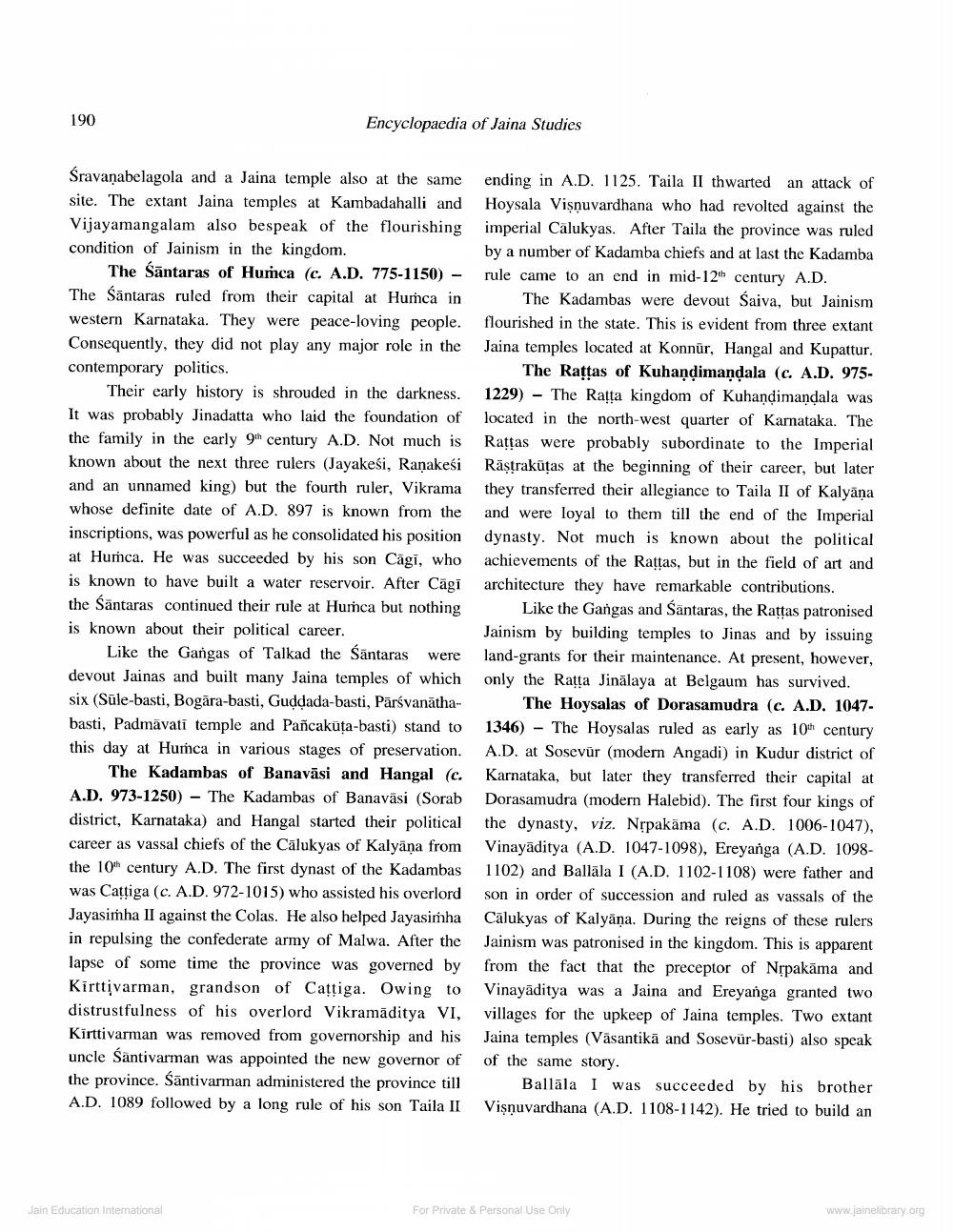________________
190
Encyclopaedia of Jaina Studies
Śravanabelagola and a Jaina temple also at the same site. The extant Jaina temples at Kambadahalli and Vijayamangalam also bespeak of the flourishing condition of Jainism in the kingdom.
The śāntaras of Humca (c. A.D. 775-1150) - The Sāntaras ruled from their capital at Humca in western Karnataka. They were peace-loving people. Consequently, they did not play any major role in the contemporary politics.
Their early history is shrouded in the darkness. It was probably Jinadatta who laid the foundation of the family in the early 9th century A.D. Not much is known about the next three rulers (Jayakesi, Raņakesi and an unnamed king) but the fourth ruler, Vikrama whose definite date of A.D. 897 is known from the inscriptions, was powerful as he consolidated his position at Humca. He was succeeded by his son Cāgi, who is known to have built a water reservoir. After Cägi the Säntaras continued their rule at Humca but nothing is known about their political career.
Like the Gangas of Talkad the Säntaras were devout Jainas and built many Jaina temples of which six (Süle-basti, Bogāra-basti, Guddada-basti, Pārsvanātha- basti, Padmavati temple and Pancaküța-basti) stand to this day at Humca in various stages of preservation.
The Kadambas of Banavāsi and Hangal (c. A.D. 973-1250) - The Kadambas of Banavāsi (Sorab district, Karnataka) and Hangal started their political career as vassal chiefs of the Cālukyas of Kalyana from the 10th century A.D. The first dynast of the Kadambas was Cattiga (c. A.D. 972-1015) who assisted his overlord Jayasimha II against the Colas. He also helped Jayasimha in repulsing the confederate army of Malwa. After the lapse of some time the province was governed by Kirttivarman, grandson of Cattiga. Owing to distrustfulness of his overlord Vikramāditya VI, Kirttivarman was removed from governorship and his uncle Santivarman was appointed the new governor of the province. Sāntivarman administered the province till A.D. 1089 followed by a long rule of his son Taila II
ending in A.D. 1125. Taila II thwarted an attack of Hoysala Vişnuvardhana who had revolted against the imperial Cālukyas. After Taila the province was ruled by a number of Kadamba chiefs and at last the Kadamba rule came to an end in mid-12th century A.D.
The Kadambas were devout Saiva, but Jainism flourished in the state. This is evident from three extant Jaina temples located at Konnūr, Hangal and Kupattur.
The Rattas of Kuhandimandala (c. A.D. 9751229) - The Ratta kingdom of Kuhandimandala was located in the north-west quarter of Karnataka. The Rattas were probably subordinate to the Imperial Rāstrakūtas at the beginning of their career, but later they transferred their allegiance to Taila II of Kalyāņa and were loyal to them till the end of the Imperial dynasty. Not much is known about the political achievements of the Rattas, but in the field of art and architecture they have remarkable contributions.
Like the Gangas and Santaras, the Rattas patronised Jainism by building temples to Jinas and by issuing land-grants for their maintenance. At present, however, only the Ratta Jinālaya at Belgaum has survived.
The Hoysalas of Dorasamudra (c. A.D. 10471346) - The Hoysalas ruled as early as 10th century A.D. at Sosevūr (modern Angadi) in Kudur district of Karnataka, but later they transferred their capital at Dorasamudra (modern Halebid). The first four kings of the dynasty, viz. Nrpakāma (c. A.D. 1006-1047), Vinayāditya (A.D. 1047-1098), Ereyanga (A.D. 10981102) and Ballāla I (A.D. 1102-1108) were father and son in order of succession and ruled as vassals of the Cālukyas of Kalyäņa. During the reigns of these rulers Jainism was patronised in the kingdom. This is apparent from the fact that the preceptor of Nrpakāma and Vinayāditya was a Jaina and Ereyanga granted two villages for the upkeep of Jaina temples. Two extant Jaina temples (Väsantikā and Sosevür-basti) also speak of the same story.
Ballāla I was succeeded by his brother Vişnuvardhana (A.D. 1108-1142). He tried to build an
Jain Education Intemational
Jain Education Interational
For Private & Personal Use Only
For Private & Personal Use Only
www.jainelibrary.org




